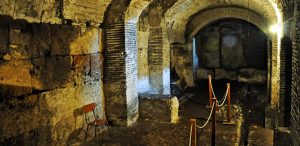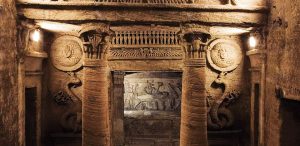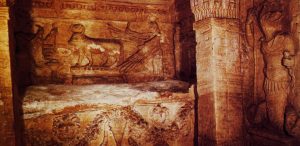+20 2 3762 0904 / +372 5923 9322 /
+44 745 225 4645
Introducción sobre Las Catacumbas de Kom El Shoqafa
Alejandría, la “novia o perla del Mediterráneo”, fue la capital de Egipto durante un largo período de tiempo. Allí se pueden observar una gran cantidad de monumentos únicos y casi imposible de encontrar en otros lugares del país. Las Catacumbas de Kom El Shoqafa constituyen uno de los atractivos históricos más importantes de Alejandría y uno de los más visitados por los turistas que visitan Egipto.
Estas catacumbas de estilo romano son maravillosos ejemplos de la influencia del arte del Antiguo Egipto en el arte romano.
Ubicación Geográfica
Las catacumbas de Kom El Shoqafa están ubicadas en el Oeste de Alejandría, al sur del barrio Mena El Basel (o “Puerto de las Cebollas”, en referencia al antiguo comercio de cebollas en esa zona)
Se puede acceder a las catacumbas en taxi desde cualquier lugar de Alejandría. Sin embargo, se aconseja reservar el tour con una agencia de viajes confiable para disfrutar de la excursión al máximo.
Historia
Las características de las Catacumbas de Kom El Shohafa, sus diseños y decoraciones permiten deducir que su construcción fue hecha en diferentes períodos, entre el siglo I y II d.C.
Algunos objetos descubiertos datan del los años 117 y 138 d.C.
Los historiadores coinciden en que las catacumbas se utilizaron hasta fines del siglo IV d.C., y después fueron abandonadas.
El descubrimiento de este importante sitio histórico fue accidental: un burro cayó en la entrada principal de las tumbas, a más de 12 metros de profundidad el 28 de Septiembre de 1900, y esto llamó la atención de la misión arqueológica que ya se encontraba trabajando en el área desde 1892.
Descripción
En la actualidad, las catacumbas de Kom El Shoqafa son una de las principales atracciones de Alejandría.
El ingreso se realiza por medio de una escalera de espiral de 6 metros de diámetro y aprox. 10 metros de profundidadque rodea un pozo de agua cilíndrico. Dicha escalera fue construida con escalones más grandes al principio y más pequeños al final, según los rituales comunes del período romano y conduce hasta un primer subsuelo. Éste consiste de un corredor que conecta con una sala circular, conocida como “la Rotonda”. En el medio de ella hay un pozo de agua. A un costado, hay una sala rectangular, que era utilizada como lugar de banquetes.
Al final de la sala circular, hay escalones que conducen a un segundo subsuelo, lleno de habitaciones, corredores, cámaras y la mayoría de las tumbas de Kom El Shoqafa.
La “rotonda” o sala circular, tiene un domo y seis columnas que lo sostienen. El pozo de agua tiene unos 8,5 metros de profundidad. Las paredes de esta sala se caracterizan por sus formas geométricas de color rojo. En el lugar, se encontraron cinco cabezas de estatuas de alabastro, que actualmente se exhiben en el museo Greco-romano de Alejandría.
La segunda sala que se puede observar, es conocida como “triclinium”. Tiene 9 metros de ancho y 8,5 metros de largo, y cuenta con las decoraciones más destacadas de Kom El Shoqafa. En esta sección se reunían los familiares del difunto para comer, durante su visita a las catacumbas.
La parte más importante del segundo subsuelo es la sala donde hay tres sarcófagos con decoraciones grecorromanas. El del medio presenta relieves sobre el complicado proceso de momificación en el Antiguo Egipto.
Las paredes de la sala tienen escenas representando al emperador romano usando su corona y presentando sus ofrendas a la diosa Isis, la cual está protegiendo al difunto con sus alas.
Al salir de la cámara principal de Kom El Shoqafa, se puede observar al dios Anubis, con ropa de soldado y armas romanas, parado frente a una puerta faraónica. Al lado derecho, también está representado el dios Anubis, pero esta vez con cuerpo humano y cola de dragón. Todas estas escenas fueron derivadas del arte mortuorio del Antiguo Egipto.
Serving as the capital of Egypt for quite a long period of time, the city of Alexandria, nicknamed as the bride of the Mediterranean Sea, is featured for hosting a number of distinctive monuments that are hard to be found anywhere else in Egypt. Among the most interesting Egyptian historical sites of Alexandria is the ancient necropolis of the Catacombs of Kom El-Shoqafa site which means mound of shards visited by a large number of travelers who tour Egypt.
Being the largest Roman burial site in Egypt and one of the most marvelous examples of the influence of the ancient Egyptian art in the Roman styles and outlines as an archaeological site, this place is a must-visit for any traveler spending his vacation in Egypt who is interested in the ancient Egyptian history and art.

It also can be reached easily by taxi from anywhere in Alexandria. However, it would be most enjoyable for a tourist touring Egypt to have an Egyptian travel company organize such visits in the land of the Nile.
The planning and layout of the Tombs of Kom El-Shoqafa, the difference in the components of its decorations, all these factors assert that they were not all established or constructed in the same period of time.

Some findings in the tombs were unearthed and they date back to the 2nd century and the years 117 and 138 AD. Historians have also noted that the tombs of Kom El Shoqafa were used until the end of the 4th century AD before they were all deserted.
The catacombs of Alexandria were discovered by mere coincidence on the 28th of September of the year 1900. Actually it was a donkey that fell in the main entrance to the tombs more than 12 meters under the ground and this grabbed the attention of the archaeological mission that started its work in the location in 1892.
Today the catacombs of Kom el shoqafa has turned to be a major touristic attraction site for travelers who spend their vacation in Egypt. The wonders of the Kom El Shoqafa tombs are in the details of its constructions

The first floor consists of a corridor that is linked to a circular shaped hall. The Rotunda, or the famous circular shaped well, is located in the middle of this hall. Aside of this hall, there is a rectangular shaped hall that served as a banquet area.
At the end of the circular hall, there is a set of stairs that leads to the second underground floor that hosts most of the tombs. The second underground floor is featured with many rooms, corridors, and chambers.
The cylinder shaped set of steps in fact revolved around a cylinder well that has a diameter of 6 meters and a depth of 10 meters. The steps at the top were actually constructed to be larger and wider than the step at the bottom. This was a common ritual in the Roman period. They believed that the people go to visit their deceased they would get tired at the top and this was why the step at the top was built to be larger and wider.

The second area the traveler visits, when he explores the Catacombs of El-Shoqafa, is the triclinium. This section consists of three levels where the family of the deceased used to gather to have a meal during their visit to the tombs.
The three levels of the triclinium consist of a large hall that 9 meters wide and 8.5 meters in length. This section is fettered with some of the most remarkable decorations in the Catacombs.

The second or the middle coffin present the complicated mummification process in ancient Egypt. The walls to the right and to the left represent a Roman emperor wearing his crown and presents the offerings to the bull god while Isis, the ancient Egyptian god, is standing with her wings to protect the deceased. This is, in fact, the most famous portrait of the Catacombs. When the guests leave the main burial chamber at the Tomb of El Shoqafa they see the god Anubis wearing the outfit of a soldier and equipped with Roman weapons. He is standing on what seems like a Pharaonic gate. To the right hand side, there is the god Anubis as well but this time he has the body of a human that has a tail of a dragon. All these scenes were derived from the ancient Egyptian mortuary arts.